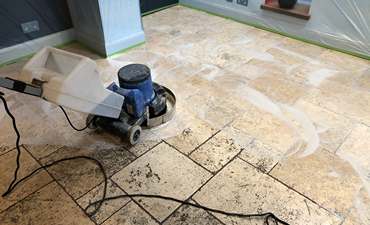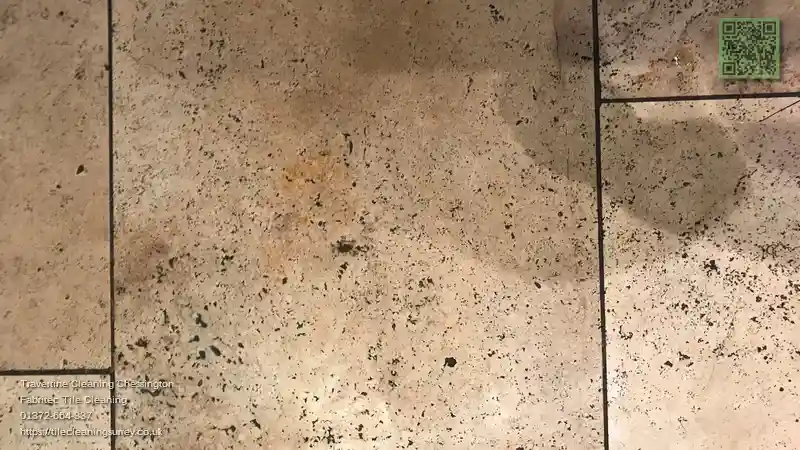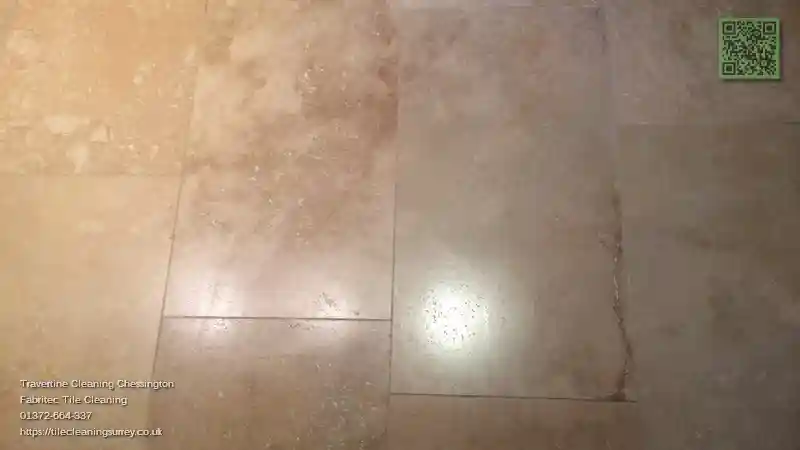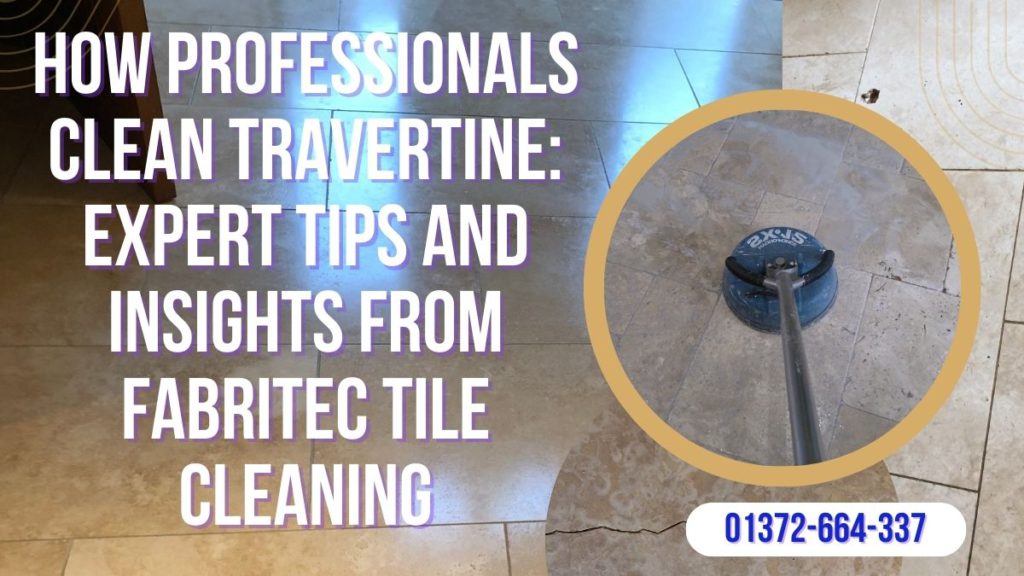Travertine Floor Restoration: A Complete Guide
Travertine floors add sophistication and timeless appeal to any space. However, their porous nature makes them prone to dirt buildup, staining, and dullness over time. Regular cleaning may not always be enough, leaving homeowners wondering:
- How do I restore the original shine of my travertine?
- What’s the best cleaner for travertine floors?
- How do professionals clean travertine without damaging it?
- Should I seal my travertine floors, and how often?
If you’ve struggled to maintain your travertine surfaces, professional cleaning may be the best solution. At Fabritec Tile Cleaning, we specialize in restoring travertine floors to their original beauty. Below, we share our expert process and tips to help you care for your travertine floors like a pro.
Why Travertine Requires Special Care
Travertine is a form of limestone that naturally develops small holes and cavities during formation. These pores give travertine its unique look but also make it highly absorbent.
Common Travertine Issues
- Dirt and grime buildup: Pores trap dust and debris, making floors appear dirty.
- Etching and dullness: Acidic substances like lemon juice or vinegar cause surface damage.
- Cracking and chipping: Heavy foot traffic or moisture exposure can weaken the stone.
- Mold and mildew growth: Bathrooms, kitchens, and outdoor pavers are susceptible to moisture-related issues.
Using improper cleaning methods can worsen these problems, which is why professional deep cleaning and sealing are essential.
Step-by-Step Process of Professional Travertine Cleaning

At Fabritec Tile Cleaning, we follow a meticulous multi-step approach to restore travertine surfaces effectively.
1. Initial Assessment and Inspection
A professional cleaning starts with a thorough inspection of the travertine surface. We check for:
- ✔ Stains and discoloration
- ✔ Cracks, chips, or missing grout
- ✔ Areas with heavy dirt accumulation
- ✔ Signs of moisture damage or mold growth
This assessment allows us to determine the best cleaning approach for your specific floor condition.
2. Pre-Treatment with pH-Neutral Cleaners
Before deep cleaning begins, we apply a pH-neutral stone cleaner. Unlike generic floor cleaners, this solution is designed to break down dirt and stains without damaging the stone.
Why pH-neutral cleaners?
- They prevent etching and dullness.
- They penetrate deep into the pores to lift dirt.
- They leave no harsh chemical residue.
3. Deep Cleaning with High-Powered Machines

After the cleaner has loosened dirt and grime, we use rotary scrubbing machines with soft-bristle brushes to lift embedded debris. These machines:
- ✔ Remove deep-seated grime without scratching the surface.
- ✔ Reach into the stone’s pores for a more thorough clean.
- ✔ Ensure even cleaning across the entire floor.
For delicate areas or detailed surfaces, we use hand scrubbing techniques to avoid damage.
4. Specialized Stain Removal Treatments
If deep stains are present, we apply targeted stain-removal techniques.
How Professionals Remove Stains from Travertine
- Organic stains (food, coffee, tea): Treated with hydrogen peroxide-based poultices.
- Oil-based stains (grease, cosmetics): Absorbed using a baking soda paste.
- Rust stains: Removed with specialty rust removers designed for natural stone.
- Water spots and mineral deposits: Dissolved with a gentle stone-safe descaler.
5. Grout Line Cleaning and Restoration
Dirty grout can make even a clean travertine floor look unkempt. We use steam cleaning and professional-grade grout brushes to remove embedded dirt from grout lines.
If grout is cracked or missing, we perform grout repair and recoloring to restore uniformity.
6. Rinsing and Residue Removal
After cleaning, we rinse the entire surface with high-pressure water to remove any leftover cleaning agents or loosened dirt. A wet vacuum is used to extract excess moisture, ensuring a faster drying time.
7. Repairing Cracks, Holes, and Surface Damage

Travertine is prone to small holes and cracks due to its porous nature. If left untreated, these imperfections collect dirt and worsen over time.
We use stone-specific fillers to repair:
- Small pits and holes
- Hairline cracks
- Chipped edges
This step enhances the stone’s appearance and prolongs its lifespan.
8. Sealing the Travertine for Long-Term Protection
Sealing is crucial for maintaining travertine’s beauty and preventing future damage. After cleaning and repairs, we apply a high-quality stone sealer.
Types of Travertine Sealers
- Penetrating Sealer: Absorbs into the stone without altering its appearance. Ideal for polished or natural travertine.
- Surface Sealer: Creates a protective barrier on top of the stone. Best for honed or filled travertine.
9. Final Inspection and Quality Check
Before finishing, we conduct a final walkthrough to ensure the entire floor is cleaned, repaired, and sealed correctly. We also provide homeowners with maintenance recommendations to keep their travertine in top shape.
Benefits of Professional Travertine Cleaning

While DIY cleaning may seem cost-effective, professional cleaning offers long-term advantages that outweigh temporary fixes.
Why Hire a Professional?
- ✔ Deep cleaning beyond surface-level dirt.
- ✔ Prevents etching and damage from harsh chemicals.
- ✔ Sealing extends the life of the stone.
- ✔ Time-saving and hassle-free service.
A professional cleaning every 12-24 months keeps travertine looking its best while preventing costly damage.
Travertine Maintenance Tips for Homeowners
To maintain travertine between professional cleanings, follow these best practices:
- Use Proper Cleaning Tools: Soft microfiber mops prevent scratches. pH-neutral stone cleaners protect the surface. Avoid abrasive scrubbers that can wear down the stone.
- Clean Spills Immediately: Travertine absorbs liquids quickly. Wipe spills immediately to prevent staining.
- Avoid Acidic and Harsh Cleaners: Never use vinegar, lemon juice, or ammonia-based products, as they can cause etching.
- Dust and Sweep Regularly: Dust and sand particles can scratch travertine. Sweep or vacuum frequently to minimize buildup.
- Reapply Sealer Annually: Re-sealing every 12-24 months maintains protection against stains and moisture.
Restore Your Travertine with Professional Care
Travertine floors are a stunning investment that requires specialized cleaning and maintenance. At Fabritec Tile Cleaning, we use advanced cleaning techniques, stain removal treatments, and high-quality sealers to restore your travertine to its original beauty.
If you’re in the New Malden area and need expert travertine cleaning, call 01372-664-337 or visit our website for more details. Let us bring your travertine floors back to life!
This post was provided by the professionals from https://tilecleaning surrey.co.uk/hounslow/travertine-cleaning.html. on behalf of Fabritec Tile Cleaning In New Malden



I found this guide super helpful! Travertine definitely has a unique charm, but that porous nature can be such a hassle. I’ve noticed that regular mopping just doesn’t cut it — I’ll have to consider professional cleaning next time.
I’ve always loved the warm look of travertine floors, but I had no idea they required such special care! The porous nature definitely makes sense now as to why they seem to attract dirt. I remember when I first moved into my place, I thought regular mopping would be enough, but after a few months, they looked pretty dull. I decided to try a home cleaning solution I found online, and while it helped a bit, I still felt like I was missing that beautiful shine that really makes travertine pop.
It sounds like you’ve been on quite the travertine journey! Those beautiful floors can be a bit of a diva—always needing just the right care to keep them shining. It’s kind of like trying to maintain a pet rock—looks great when you get it, but if you don’t give it a little attention, it can start to lose its charm.
I completely understand your experience! To help you bring back that beautiful shine and maintain your travertine floors, I found a great resource that offers tips and products specifically designed for caring for travertine. You might find it really helpful!
https://fabritec.org/lp
I can totally relate to your experience with travertine floors. They have such a classic charm, but it can be a bit of a learning curve when it comes to maintenance. I remember when I first moved into my place, I was so excited about my new travertine tiles. I thought a mop and some warm water would keep them sparkling. Like you, I was surprised to see them lose their luster over time.
I can relate to that initial excitement—there’s something so appealing about the look of travertine, isn’t there? It’s like you have a piece of nature right in your home. I also started with the mop and warm water approach, thinking that would do the trick. It’s a bit sobering to realize they need more than just the basics to really shine.
It’s refreshing to see a comprehensive guide on travertine floor restoration. I’ve always been fascinated by how natural materials like travertine can bring elegance to a space, but I’ve also struggled with maintaining their beauty. The porous nature indeed poses a challenge.
Restoring travertine floors can be quite the endeavor, can’t it? I’ve had the same struggle in my home, where my once-lustrous floors started looking a bit lackluster. I found that using a pH-neutral cleaner really made a difference, but I also learned that over-cleaning can sometimes cause more harm than good due to the porous nature of travertine.
I’ve always admired how elegant travertine floors look, but I never realized how much upkeep they require! I recently had a small mishap when I spilled red wine on mine during a gathering, and it was a complete panic trying to clean it up. I ended up using a baking soda paste, which helped a bit, but now I’m curious about those professional restorations you mentioned.
Ah, travertine floors—gorgeous to look at but about as forgiving as a cat on a sticky rug! I learned the hard way that it’s not just a “sweep it under the rug” situation. I once thought lemon juice was the answer to everything, including cleaning my travertine. Turns out, my floors looked less “Italian marble” and more “sour lemon” after that experiment!
Restoring travertine floors is indeed an art and a science. I’ve always appreciated how natural stone can transform a space, giving it character and warmth. Yet, the challenge of maintaining that beauty is real. I’ve found that using a pH-neutral cleaner specifically designed for stone can work wonders, but it’s the sealing process that makes a significant difference in longevity.
Restoring travertine floors combines both the practical aspects of maintenance and the artistic vision for enhancing a space. You’re right in noting that natural stone brings a unique warmth and character to any environment; it has a way of grounding the aesthetics of a room while also connecting us to the earth.
It’s interesting how travertine floors can instantly elevate a home’s aesthetic. I’ve always loved the look but found maintaining them quite a challenge. I recently tried a pH-neutral cleaner specifically designed for natural stone, and it made a noticeable difference in brightness without risking any damage. I’m curious about your thoughts on using DIY solutions versus professional services. Have you found any at-home methods that really work, or is it best to leave it to the experts? I wonder how often others choose to seal their floors, too—I’ve read conflicting advice on that!
I really appreciate your insights into travertine floor restoration. I’ve always admired the elegance of travertine, but I often find myself feeling overwhelmed by how to maintain it properly. A few weeks ago, I tried a DIY cleaning solution that I found online, and while it worked okay, I noticed some areas still looked dull.